#princess nicholas of greece
Explore tagged Tumblr posts
Text

Grand Duchess Elena Vladimirovna of Russia on her wedding day to Prince Nicholas of Greece and Denmark, 1902.
#Grand Duchess Elena Vladimirovna of Russia#imperial russia#imperial family#russian imperial family#romanovs#colored photography#1902#1900s#1900s fashion#russian court dress#grand duchess elena of russia#grand duchess elena vladimirovna#princess nicholas of greece#history colored#edwardian
31 notes
·
View notes
Text

The Marriage of Nicholas II, Tsar of Russia, 26th November 1894
Artist: Laurits Regner Tuxen (Danish, 1853-1927)
Date: 1895-1896
Medium: Oil on canvas
Collection: Royal Collection Trust, United Kingdom
Description
The wedding between Nicholas II and Princess Alix of Hesse took place in the Imperial Chapel of the Winter Palace on 26 November 1894, just over twenty years after the marriage of the Tsar's aunt in the same chapel. The wedding was announced in April that year and was to take place on the Empress Marie Feodorovna's birthday. Tragically, Emperor Alexander III died of kidney disease on 1 November, and the court was thrown into mourning with the exception of the day of the marriage.
The royal couple stand, holding lighted candles, whilst the Metropolitan Archbishop of St Petersburg, Mgr Palladius, makes the sign of the cross before them. Ella, (Grand Duchess Elizabeth Feodorovna), writing to her grandmother, Queen Victoria, described her sister's dress as 'embroidered silver cloth Russian court dress & very pretty', helpfully including a sketch. She added that 'Alix being tall will look perfectly lovely'. She wears a kokoshnik tiara and a small diamond crown, beneath which is a wreath of orange blossom, her imperial gold-embroidered mantle is lined with ermine. The Tsar is dressed in the uniform of a Hussar. In the background George I, King of Greece stands to the left of Christian IX, King of Denmark, who looks towards his daughter, the Dowager Empress; the Princess of Wales, and the Queen of Greece. The Prince of Wales can be seen dressed in the uniform of Russian Dragoons to the right of the portrait.
#painting#wedding#marriage#nicholas ii#tsar of russia#princess alice of hesee#imperial chapel#winter palace#royal couple#lighted candles#archbishop#embroidered silver cloth dress#russian court dress#kokoshnik tiara#diamond crown#orange blossom#imperial gold embroidered mantle#ermine#uniform of a hussar#george i king of greece#dowager empress#princess of wales#queen of greece#uniform of russian dragons#portrait#oil on canvas#artwork#fine art#russian history#danish painter
47 notes
·
View notes
Text

Princess Alice of Battenberg and Tsar Nicholas II of Russia. About 1901.
Nicholas was married to Alexandra, who was the youngest sister of Alice's mother, Victoria. Alexandra and Victoria were born Princesses of Hesse and by Rhine and granddaughters of Queen Victoria via her second daughter, Alice.
In 1903 Alice would marry Prince Andrew of Greece and Denmark, a cousin of Nicholas' and her last born child would become Prince Philip, Duke of Edinburgh, the husband of Queen Elizabeth II. Alice was the grandmother of King Charles III.
Though congenitally deaf, Alice learned to read lips and speak English and German, and also later Greek, the language of her new homeland.
#russian royalty#royalty#romanovs#history#imperial russia#british royalty#german royalty#tsar nicholas ii#russian history#royal women#Princess Alice of Battenberg#Princess Andrew of Greece and Denmark#Princess Alice of Greece and Denmark#Greek Royalty
27 notes
·
View notes
Text

⋆ ˚。⋆୨♡୧⋆ ˚。⋆
King George I of Greece, Prince Nicholas , Prince Constantine, Princess Alexandra, Prince George and Queen Olga in 1877. Garden scene painted on backdrop. 🫶
#🥹😻#king george i of greece#queen olga#prince nicholas#prince constantine#princess alexandra#prince george#greek royal family#greek royalty#house of glücksburg#glücksburg#old royal#old royal photos#royal#royals#vintage photo#1870s#19th century
30 notes
·
View notes
Text

Grand Duchess Elena Vladimirovna of Russia, later Princess Nicholas of Greece and Denmark
Greek vintage postcard
#ephemera#photography#vintage#briefkaart#grand duchess#elena#nicholas#carte postale#postcard#photo#later#greece#vladimirovna#sepia#ansichtskarte#duchess#greek#grand#postkarte#postkaart#russia#elena vladimirovna#princess#postal#denmark#tarjeta#historic
9 notes
·
View notes
Text
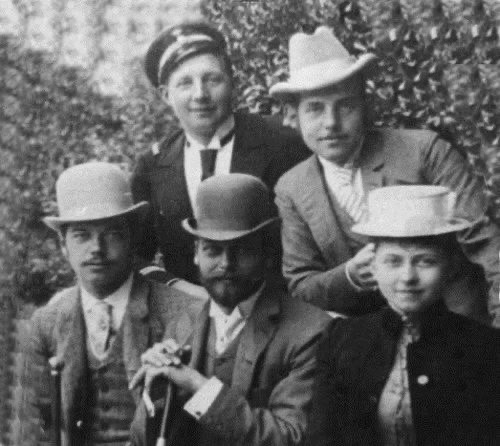
Tsesarevich Nicholas, Prince George of Wales, Princess Sophia of Prussia, Crown Prince Constantine of Greece and Prince George of Greece and Denmark 1890s.
#Tsesarevich Nicholas#prince george of wales#Princess Sophia of Prussia#crown Prince Constantine#George of Greece and Denmark#nicholas ii#George v#Queen sophia of Greece#Constantine i#1890s
38 notes
·
View notes
Text
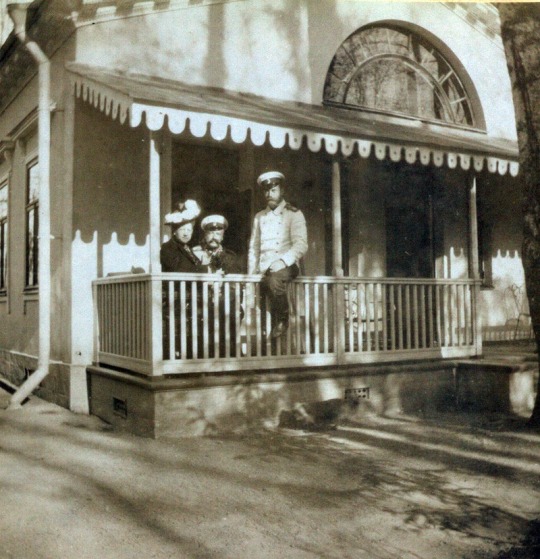
Nicholas II with Princess Maria of Greece and Grand Duke George Milhailovich.
#princess maria of greece#greece#tsar nicholas ii#grand duke george mikhailovich#tsar#my own#grand duke
22 notes
·
View notes
Text
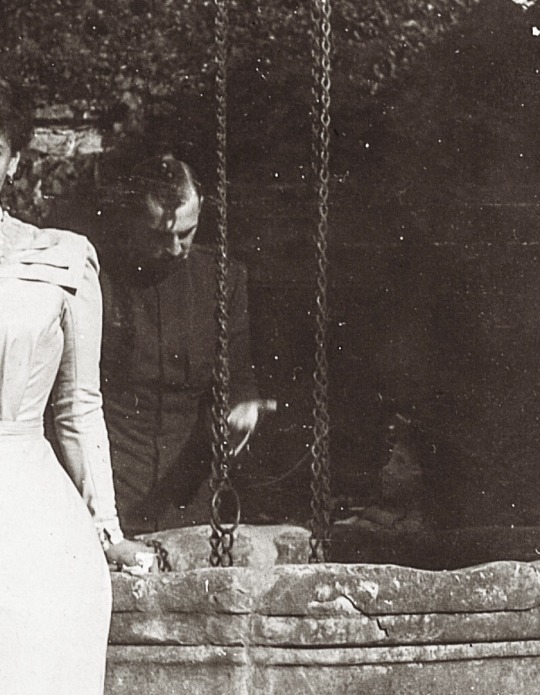
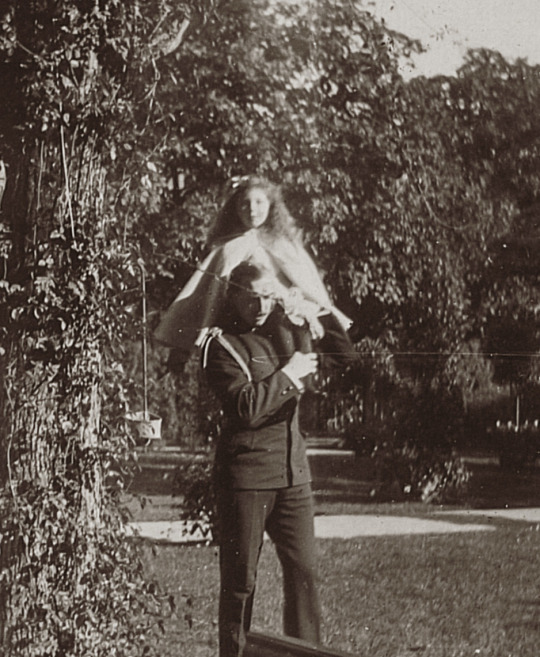
Candid moments between Prince Nicholas of Greece and Denmark aka “Greek Nicky” with his 1st cousin once removed, Princess Elisabeth “Ella” of Hesse, Wolfsgarten, Darmstadt, 1899
#awe cuties 🥰#✨😍🤍#prince nicholas of greece and denmark#prince Nicholas#greek royal family#princess elisabeth of hesse#ella of hesse#elisabeth of hesse#hessian royal family#hesse#wolfsgarten#1899#Nicholas of Greece and Denmark#greek Nicky#danish royal family
23 notes
·
View notes
Text

Rare photo of the 5 eldest children of King George I of Greece and Grand Duchess Olga Konstantinovna of Russia, 1880(?)
from left to right: George, Marie “Minnie”, Constantine, Nicholas, and Alexandra
#greek royal family#king Constantine i#king Constantine I of greece#prince george#prince George of Greece and Denmark#princess Alexandra of Greece and Denmark#Alexandra georgievna#prince Nicholas of Greece and Denmark#Princess Marie of Greece and Denmark#maria georgievna#1880#1880s#1870s
6 notes
·
View notes
Text
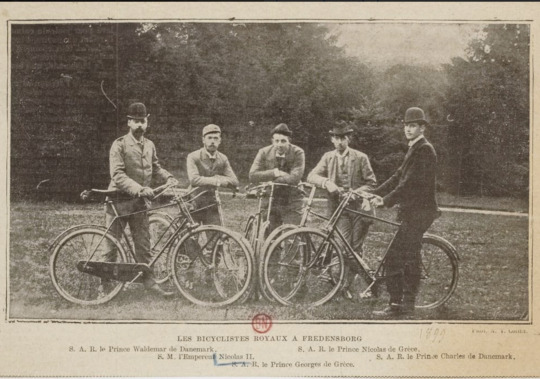
THE BICYCLE WAS ALL THE RAGE, SO THE ROYALS HAD TO GET INTO CYCLING
On the photo above, from left to right: Prince Valdemar of Denmark, Emperor Nicholas II, “Greek Georgie” (Prince George of Greece), “Greek Nicky” (Prince Nicholas of Greece) and Prince Christopher of Denmark. These guys really dressed up to go riding…neck tie, hat…
On the photo below, from left to right, Grand Duke Mikhail Alexandrovich…the jock of the group as usual, notice the handle of his bike; Cousin Victoria of Wales with an incredibly small waist, Queen Maud and her handsome and intelligent husband Hakoon VII.
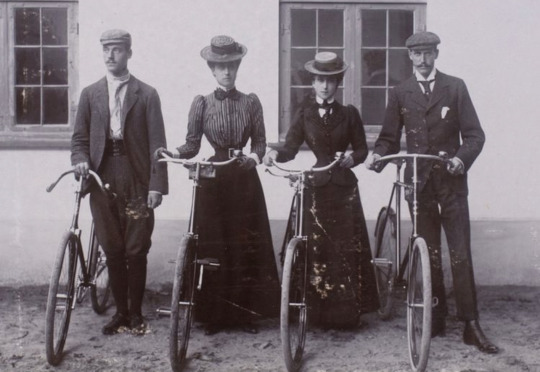
#russian history#imperial russia#nicholas ii#vintage photography#prince nicholas of greece and denmark#prince george of greece#Grand Duke Mikhail Alexandrovich#Princess Victoria of Wales#Queen Maud of Norway#King Haakon VII of Norway#prince Charles of denmark
17 notes
·
View notes
Text

Prince Nicholas & Grand Duchess Elena
#prince nicholas of greece and denmark#grand duchess elena#princess marina#princess olga#princess elizabeth of greece and denmark
0 notes
Text
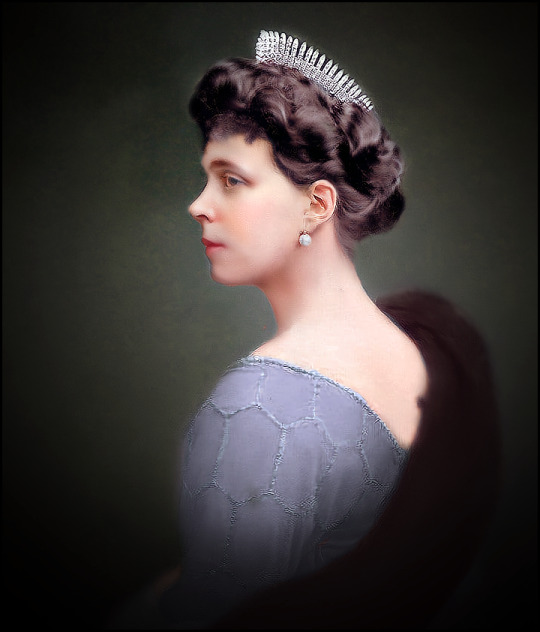
Grand Duchess Elena Vladimirovna of Russia, Princess Nicholas of Greece and Denmark, 1910s.
#Grand Duchess Elena Vladimirovna of Russia#grand duchess elena vladimirovna#grand duchess elena of russia#princess nicholas of greece#romanovs#imperial russia#russian imperial family#imperial family#greek royals#greek royalty#greek royal family#1910s#1910s fashion#colored photography#history colored
23 notes
·
View notes
Photo
Wonderful dry point work by Nicholas Panagiotti Zarokilli




Greek Princesses (and Romanov descendants), Olga, Elizabeth and Marina and their father Prince Nicholas of Greece and Denmark. They were the daughters of Prince Nicholas of Greece and Grand Duchess Elena Vladimirovna. Their paternal grandparents were King George I of Greece and Queen Olga Konstantinovna. Their maternal grandparents were Grand Duke Vladimir Alexandrovich and Grand Duchess Maria Pavlovna the Elder. During their various periods of exile from Greece, “Greek Nicky” was able to earn money for the family by selling his artwork. Elizabeth and Marina inherited their father’s artistic talent; Marina would sign her work as Marina de Grece or “MG,” and then after her marriage as “MK” for Marina of Kent.
#russian history#romanov dynasty#greek royal family#Greek Nicky#Grand Duchess Elena Vladimirovna#Prince Nicholas of Greece#Nicholas Panagiotti Zarokilli#Princess Olga of Greece#Princess Marina of Greece#Princess Elizabeth of Greece
213 notes
·
View notes
Text

"...Grand Duchess Helene— Princess Nicholas of Greece—was most attractive. She had a typically Russian nose, lovely mysterious eyes of a strange yellowish-hazel, level eyebrows, and a friste, interesting smile, full of passion and melancholy, but strangely charming. She had the same brushed-up ondulé hair as the rest, but her dress was much more chic than most, though all were well made. She said the kindest things about my books and seemed to know them well, which flattered me greatly".
Elinor Glyn "Romantic adventure"
64 notes
·
View notes
Text

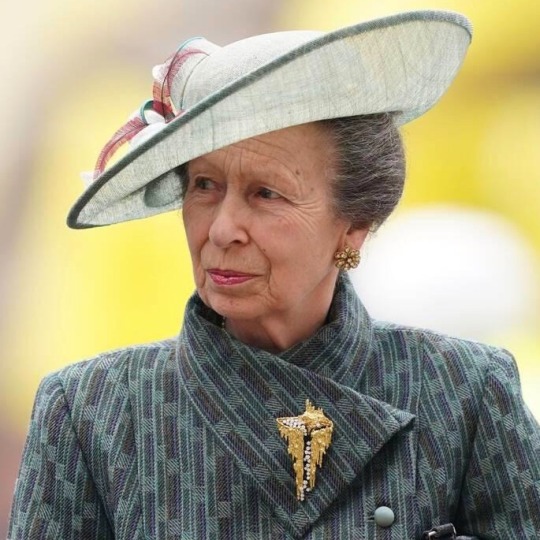
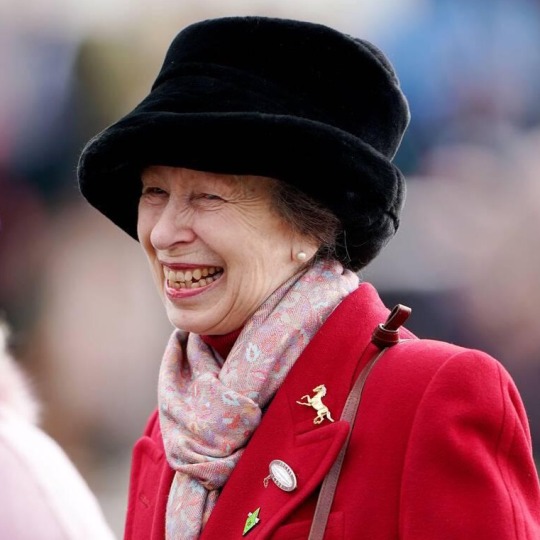
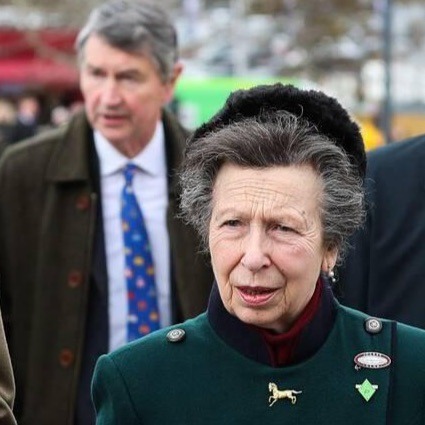

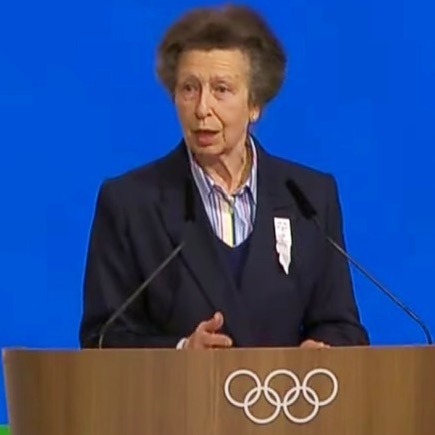


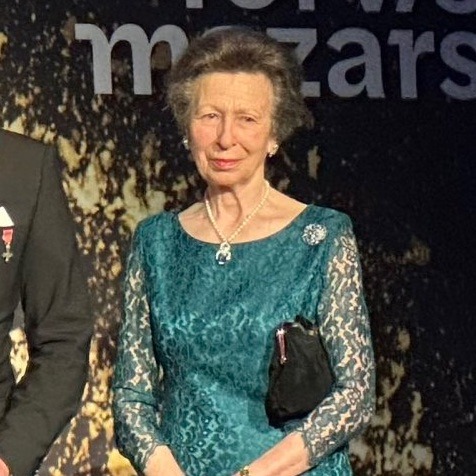
The Princess Royals Official Engagements in March 2025
03/03 Opened Minchinhampton Surgery in Minchinhampton near Stroud. 🩻👩⚕️
04/03 unofficial Sir Tim, as President of Kent Cricket Club, attended a memorial service at Canterbury Cathedral for former England spin bowler Derek Underwood. 🏏🤍
On behalf of The King, held an Investiture at the Palace of Holyroodhouse. 🎖️🏴
Attended a Royal Warrant Holders Association Reception at the Palace of Holyroodhouse. 📜🍽️
05/03 unofficial The King was represented by Dame Sarah Troughton (His Majesty’s Lord-Lieutenant of Wiltshire) at the Service of Thanksgiving for the Life of Lieutenant General Sir Maurice Johnston (formerly Her late Majesty’s Lord-Lieutenant of Wiltshire), held at St John’s Church in Devizes. The Princess Royal was represented by Captain Sir Nicholas Wright RN. 🕊️
As Patron of Maritime UK, chaired a National Council Meeting at the offices of Gallagher, the Walbrook Building, in London. ⚓️💼
As Chancellor of the University of London, opened King’s College London’s new Engineering Building. 🦾🦿
As Patron of the Maritime Society and Sea Cadets, and Admiral of the Sea Cadet Corps, held a Reception at Buckingham Palace. ⚓️🫡
06/03 As President, this afternoon attended the National Equine Forum at the Institution of Mechanical Engineers in London. 🐎
As Grand Master of the Royal Victorian Order, attended Evensong and a Reception at The King’s Chapel of the Savoy in London. ⛪️
07/03 As Admiral and Patron, this morning visited the Royal Naval Sailing Association in Gosport. ⛵️
Opened the new Emergency Department at Queen Alexandra Hospital in Portsmouth. 🏥
As Patron of Maritime UK, attended a Coastal Powerhouse Summit Reception at Portsmouth International Port. 🔋
08/03 With Sir Tim As Patron of the Scottish Rugby Union, attended the International Rugby Match between Scotland and Wales at Murrayfield Stadium in Edinburgh. 🏴🏴🏉
As Patron of Scottish Garden City Housing Society Limited, attended the 110th Anniversary Reception at Edinburgh Castle.🏡🥂
10/03 As Patron of the Canal Museum Trust, opened the “Building Britain’s Canals” Temporary Exhibition at the London Canal Museum. 💦🛶
Alongside The King and Queen, The Prince and Princess of Wales and The Duke and Duchess of Gloucester attended the Commonwealth Day Service of Celebration in Westminster Abbey. 🌍⛪️
11/03 As Past Master of the Worshipful Company of Butchers, attended the Annual City Food and Drink Lecture at Guildhall in London. 🍝🍷✍️
13/03 Unofficial Attended St Patrick’s Thursday of Cheltenham Races. ☘️🏇🏼
14/03 With Sir Tim Attended Gold Cup Friday of Cheltenham Races. 🏆🏇🏼
15/03 With Sir Tim As Patron of the Scottish Rugby Union, attended the International Rugby Match between France and Scotland at Stade de France, Paris. 🇫🇷🏴🏉
17/03 As Patron of Save the Children UK, attended the 30th Anniversary International Financial Review Annual Awards Dinner at the Grosvenor House Hotel in London. 🍽️
Unofficial As Chair of the Board of Trustees of the Science Museum, Sir Tim attended the Premiere of the Thinking Game and presented Science Museum Fellowship awards. 🎬🧬
18/03 Unofficial Departed from Heathrow Airport and arrived at Athens International Airport. 🇬🇧✈️🇬🇷
19/03 As Member of the International Olympic Committee, and Chairman of the Members Election Commission, attended day one of the International Olympic Committee Session at the Romanos in Costa Navarino, Greece. 🇬🇷
20/03 As Member of the International Olympic Committee, and Chairman of the Members Election Commission, attended day two of the International Olympic Committee Session at the Romanos in Costa Navarino, Greece. 🇬🇷
21/03 As Member of the International Olympic Committee, and Chairman of the International Olympic Committee Members Election Commission, attended day three of the International Olympic Committee Session at the House of Events, the Romanos Hotel in Costa Navarino, Greece. 🇬🇷
Unofficial Departed from Greece and arrived back at RAF Brize Norton. 🇬🇷✈️🇬🇧
24/03 As President of the Royal Society for the Encouragement of Arts, Manufactures and Commerce, attended the President’s Panel Discussion and Dinner. 🍽️
25/03 Joined by the King, As Patron of the Butler Trust, held the Annual Awards Ceremony at St James’s Palace, followed by a Reception.
26/03 As Patron of the Royal College of Emergency Medicine, attended the Spring Conference at Birmingham Repertory Theatre. 💊
As Colonel-in-Chief of The Royal Corps of Signals, inspected 22 Signal Regiment on public duties at St James’s Palace. 🫡
With Sir Tim As President of the Royal Commission for the Exhibition of 1851, attended a Presidential Dinner at Fishmongers’ Hall in London. 🎪🍽️
27/03 On behalf of The King, held an Investiture at Buckingham Palace. 🎖️
As Colonel of The Blues and Royals (Royal Horse Guards and 1st Dragoons), attended a Service of Thanksgiving for the new Organ at the Guards’ Chapel, Wellington Barracks, London. ⛪️🎹
As Patron of the British Quality Foundation, this attended the United Kingdom Awards Ceremony and Dinner at Wembley Stadium. 🏟️
28/03 On behalf of The King, held an Investiture at Buckingham Palace. 🎖️
Total official engagements for Anne in January: 34
2025 total: 97
Total official engagements accompanied/represented by Tim in January: 4
2025 total: 4
#busy lady 🫡#princess anne#princess royal#tim laurence#timothy laurence#aimees unofficial engagement count 2025#march 2025
33 notes
·
View notes
Text

Through her visits to her mother's family, Alexandra was no stranger to Russia or for that matter to the Orthodox religion, in which she too had been brought up. Settling into a palace of their own behind the Church of the Annunciation on the Neva embankment in St Petersburg, Paul and Alexandra's closest friends and companions were Ella and Serge. In fact, the two young grand duchesses, Elisabeth Feodorovna and Alexandra Georgievna, not only became great friends but were like sisters, as close to one another as their husbands had always been. 'I do love her so dearly', Ella wrote on one occasion to Alexandra's brother Prince Nicholas of Greece and in a further letter referred to herself as 'your own sisters sister'. (...) After doing the rounds of the family sick beds [after a typhus epidemic in 1889], which she likened to visiting a 'real family hospital', Ella, whose own evidently robust state of health saw her safely through the epidemic, went to sit with Alexandra Georgiyevna, who was now four months pregnant with her first child. Seeing Paul ill, Ella wrote, 'makes her very nervous and she will think it worse than it really is'. To help distract her, Ella took Alexandra to the opera (...). A month later, the epidemic had started to pass and the sick were restored to health. Despite a very high wind which whipped up the waters of the Neva and the city's canals, Serge and Paul both ventured out of doors, albeit by carriage. Their destination was the Winter Palace where, during the first week of December, they took part in a reading of a forthcoming production of Tolstoy's Tsar Boris, in which they were both to appear. With the Emperor's permission, the play was staged in the Hermitage theatre at the end of January.
"Ella: Princess, Saint And Martyr" - Christopher Warwick

#paul alexandrovich#alexandra georgievna#elizabeth feodorovna#sergei alexandrovich#romanov#romanov family#19th century#greek royal family#imperial russia
48 notes
·
View notes